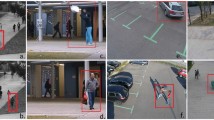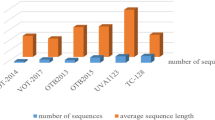Abstract
This paper presents a description of an event detection algorithm based on trajectories designed for closed-circuit television (CCTV) surveillance systems. Following the foreground segmentation, blob and scene basic characteristics—blob position or speed and people density—are used to create low-level descriptions of predefined events. Comparing sequence parameters with the semantic description of the events associated with the current scenario, the system is able to detect them and raise an alert signal to the operator, the final decision-maker. In the approach presented here, the specific demands for CCTV surveillance systems applied to public transport environments will be analysed, together with the appropriate image processing techniques in order to build an intelligent surveillance system able to detect “potentially dangerous situations.”






Similar content being viewed by others
References
Norris C, Moran J, Armstrong G (1998) Surveillance, closed circuit television and social control. Ashgate, Aldershot, UK
Armitage R (2002) To CCTV or not to CCTV? Nacro, UK, available at http://www.nacro.org.uk/data/briefings/nacro-2002062800-csps.pdf
Langlais A (2003) User needs analysis. CROMATICA technical report TR-1016, CEC Framework IV Telematics Applications Programme, available at http://dilnxsrv.king.ac.uk/cromatica/D2_WP3.pdf
Buxton H, Gong S (1995) Visual surveillance in a dynamic and uncertain world. Artif Intell 78:431–459
Aggarwal JK, Cai Q (1999) Human motion analysis: a review. Comput Vis Image Und 73(3):428–440
Gavrila DM (1997) The visual analysis of human movement: a survey. Comput Vis Image Und 73:82–98
De la Torre F, Martinez E, Santamaria ME, Moran JA (1997) Moving object detection and tracking system: a real-time implementation. In: Proceedings of the 16th Gretsi symposium on signal and image processing (GRETSI’97), Grenoble, France, September 1997, pp 375–378
Wren CR, Azarbayejani A, Darrel T, Pentland P (1997) Pfinder: real-time tracking of the human body. IEEE Trans Pattern Anal Machine Intell 17(6):780–785
Rosales R, Claroff S (1998) Improved tracking of multiple humans with trajectory prediction and occlusion modeling. In: Proceedings of the IEEE conference on computer vision and pattern recognition (CVPR’98), Santa Barbara, California, June 1998
Haritaoglu I, Harwood D, Davis LS (2000) W4: real-time surveillance of people and their activities. IEEE Trans Pattern Anal Machine Intell 22(8):809–822
McKenna S, Jabri S, Duric Z, Rosenfeld A, Wechsler H (2000) Tracking groups of people. Comput Vis Image Und 80:42–56
Agbinya JI, Rees D (1999) Multi-object tracking in video. Real-Time Imaging 5:295–304
Intille SS, Davis JW, Bobick AF (1997) Real-time closed-world tracking. In: Proceedings of the IEEE conference on computer vision and pattern recognition (CVPR’97), Santa Barbara, California, June 1998, pp 697–703
Corvee E, Velastin SA, Jones GA (2003) Occlusion tolerant tracking using hybrid prediction schemes. Acta Automatica Sin/Chinese J Automat 23(3)
Fuentes LM, Velastin SA (2001) People tracking in surveillance applications. In: Proceedings of the 2nd IEEE international workshop on performance evaluation of tracking and surveillance (PETS 2001), Kauai, Hawaii, December 2001
Rosales R, Sclaroff S (1999) 3D trajectory recovery for tracking multiple objects and trajectory guided recognition of actions. In: Proceedings of the IEEE conference on computer vision and pattern recognition (CVPR’99), Fort Collins, Florida, June 1999, vol 2, pp 23–25
Li X, Porikil F (2003) Traffic congestion estimation using HMM models without vehicle tracking. Available at http://vision.poly.edu:8080/~fporikli/traffic.html
Rota N, Thonnat M (2000) Video sequence interpretation for visual surveillance. In: Proceedings of the 3rd IEEE international workshop on visual surveillance (VS 2000), Dublin, Ireland, July 2000, pp 59–68
Morellas V, Paulidid I, Tsiamyrtzis P (2003) DETER: detection of events for thread evaluation and recognition. Mach Vis Appl 15:29–45
VACE program (2003) Video analysis and content exploitation (VACE) program. Advanced research and development activity (ARDA) group, homepage att http://www.ic-arda.org/InfoExploit/vace/index.html
PRISMATICA project (2003) Pro-active integrated systems for security management by technological institutional and communication assistance (PRISMATICA) European project , homepage at http://www.prismatica.com
ADVISOR project (2003) Annotated digital video for intelligent surveillance and optimsed retrieval (ADVISOR) project. European project, homepage at http://www-sop.inria.fr/orion/ADVISOR/news1.html
Chowdhury AM, Chellappa R (2003) A factorization approach for activity recognition. In: Proceedings of the 2nd IEEE workshop on event mining: detection and recognition of events in video, in association with the IEEE conference on computer vision and pattern recognition (CVPR 2003), Madison, Wisconsin, June 2003
Nevatia R, Zhao T, Hongeng S (2003) Hierarchical language-based representation of events in video steams. In: Proceedings of the 2nd IEEE workshop on event mining: detection and recognition of events in video, in association with the IEEE conference on computer vision and pattern recognition (CVPR 2003), Madison, Wisconsin, June 2003
Guler S, Liang WH, Pushee IA (2003) A video event detection and mining framework. In: Proceedings of the 2nd IEEE workshop on event mining: detection and recognition of events in video, in association with the IEEE conference on computer vision and pattern recognition (CVPR 2003), Madison, Wisconsin, June 2003
Fuentes LM (2002) Assessment of image processing techniques as a means of improving personal security in public transport (PerSec). Engineering and physical sciences research council (EPSRC) project final report
Velastin SA, Vicencio-Silva MA, Lo B, Sun J, Khoudour L (2002) A distributed surveillance system for improving security in public transport networks. Meas Control 35(8):209–213
Fuentes LM, Velastin SA (2001) Foreground segmentation using luminance contrast. In: Proceedings of the WSES/IEEE conference on speech, signal and image processing (SSIP 2001), Malta, September 2001, pp 2231–2235
Plataniotis KN, Venetsanopoulus AN (2000) Colour image processing and applications. Springer, Berlin Heidelberg New York
Boghossian B (1999) Evaluation of motion-based algorithms for automated crowd management. In: Proceedings of the 1st international conference on vision systems (ICVS’99), workshop on performance characterisation and benchmarking of vision systems, Gran Canaria, Spain, January 1999
Caminada JF, van Bommel WJM (1980) Residential area lighting. Engineering report 43, Lighting Design and Engineering Centre, NV Philips Gloeilampenfabrieken, Eindhoven, The Netherlands
Hall ET (1963) A system for the notation of proxemic behavior. Am Anthropol 65:1003–1026
CAVIAR project (2002) CAVIAR: context aware vision using image-based active recognition. Funded by the EC’s information society technology’s programme, project IST 2001 37540, homepage at http://homepages.inf.ed.ac.uk/rbf/CAVIAR/
Author information
Authors and Affiliations
Corresponding author
Rights and permissions
About this article
Cite this article
Fuentes, L.M., Velastin, S.A. Tracking-based event detection for CCTV systems. Pattern Anal Applic 7, 356–364 (2004). https://doi.org/10.1007/s10044-004-0236-z
Received:
Accepted:
Published:
Issue Date:
DOI: https://doi.org/10.1007/s10044-004-0236-z




